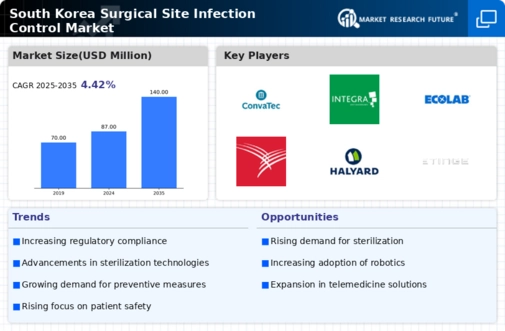Rising Surgical Procedures
The increasing number of surgical procedures in South Korea is a primary driver for the surgical site-infection-control market. As the population ages and the prevalence of chronic diseases rises, the demand for surgical interventions escalates. In 2025, it is estimated that over 1.5 million surgeries will be performed annually in South Korea, leading to a heightened focus on infection control measures. Hospitals and surgical centers are investing in advanced sterilization techniques and infection prevention protocols to mitigate the risk of surgical site infections. This trend indicates a growing recognition of the importance of maintaining high standards of hygiene and safety in surgical environments, thereby propelling the surgical site-infection-control market forward.
Rising Healthcare Expenditure
The upward trend in healthcare expenditure in South Korea is a crucial driver for the surgical site-infection-control market. With healthcare spending projected to reach 10% of GDP by 2025, hospitals are allocating more resources towards infection control measures. This increase in funding allows for the procurement of advanced sterilization equipment and the implementation of rigorous infection prevention protocols. Furthermore, as patients become more aware of the risks associated with surgical procedures, they are demanding higher standards of care, prompting healthcare providers to enhance their infection control practices. Consequently, the surgical site-infection-control market is expected to benefit from this increased investment in healthcare quality.
Increased Focus on Patient Safety
There is a growing emphasis on patient safety within the healthcare sector, which is significantly impacting the surgical site-infection-control market. Hospitals are increasingly prioritizing infection prevention as part of their quality assurance programs. This shift is driven by both regulatory requirements and patient expectations for safer surgical experiences. In South Korea, healthcare institutions are implementing comprehensive infection control protocols, which include preoperative screening and postoperative monitoring. As a result, the surgical site-infection-control market is likely to expand as hospitals invest in training staff and adopting best practices to ensure patient safety and minimize infection risks.
Government Initiatives and Funding
Government initiatives aimed at improving healthcare quality and patient safety are significantly influencing the surgical site-infection-control market. In South Korea, the Ministry of Health and Welfare has launched various programs to enhance infection control practices in healthcare facilities. These initiatives often include funding for training healthcare professionals and upgrading medical equipment. For instance, a recent allocation of $50 million for infection control measures in hospitals underscores the government's commitment to reducing surgical site infections. Such financial support not only encourages hospitals to adopt better practices but also fosters innovation in infection control technologies, thereby stimulating market growth.
Emerging Infection Control Technologies
The surgical site-infection-control market is experiencing a surge in innovative technologies designed to prevent infections during surgical procedures. Advancements in antimicrobial coatings, sterilization equipment, and monitoring systems are becoming increasingly prevalent. For example, the introduction of smart surgical instruments equipped with real-time infection monitoring capabilities is revolutionizing the way infections are managed in operating rooms. The market for these technologies is projected to grow at a CAGR of 8% through 2027, reflecting the increasing demand for effective infection control solutions. As healthcare providers seek to enhance patient outcomes, the adoption of these cutting-edge technologies is likely to drive the surgical site-infection-control market further.

















Leave a Comment